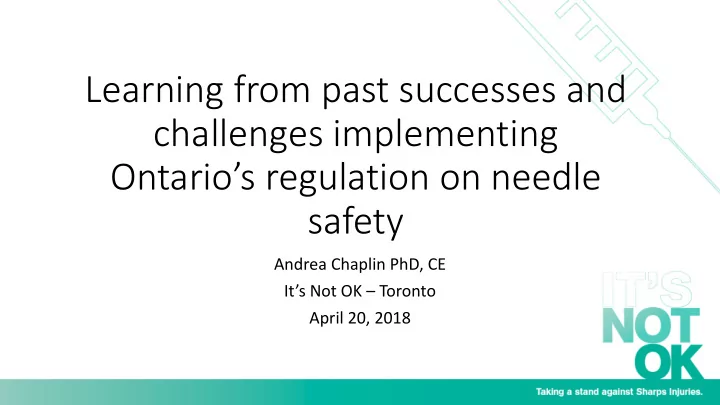

Learning from past successes and challenges implementing Ontario’s regulation on needle safety Andrea Chaplin PhD, CE It’s Not OK – Toronto April 20, 2018
Ontario’s regulation on needle safety • When a worker is to do work requiring the use of a hollow-bore needle, the employer shall provide the worker with a safety- engineered needle that is appropriate for the work. O. Reg. 474/07, s. 3 (1). • “ safety-engineered needle ” means, • a hollow-bore needle that is designed to eliminate or minimize the risk of a skin puncture injury to the worker • a needleless device that replaces a hollow-bore needle
Why regulate? Burden • 1-5 needlestick injuries occur per 1000 workers per year without intervention 1 • Primary source of occupational exposure to blood among healthcare workers • Psychological impacts post-exposure • $65-$4,800 post-exposure testing and treatment 2 Solution Problem Safety-engineered needles (SENs) Slow transition to SENs 1. Reddy et al., 2017. Devices for preventing percutaneous explore injuries caused by needles in healthcare personnel. Cochrane Database of Systematic Reviews 2017, Issue 11. CD009740. 2. Lee et al. 2005. Needlestick injuries in the United States: Epidemiologic, economic and quality of life issues. AAOHN Journal 53(3):117-34.
Ontario workers’ compensation claims (2004-2012) Rate of needlestick injuries per 10,000 FTEs (1) Regulation established Effective dates: A A) Hospitals B B) Long-term care C C) All workplaces Chambers et al. 2015. Trends in needlestick injury incidence following regulatory change in Ontario, Canada (2004-2012): An observational study. BMC Health Services. 15: 127
How can we further reduce injuries? • Difficult to answer in the absence of information on how organizations responded, how organizations managed the change process, and what is contributing to ongoing injury risk. • Ontario’s regulatory standard on needle safety was designed to be flexible – how and what will be implemented is dependent on organizations Research Dissemination Adoption Implement Outcomes Regulation
Safety Needle Implementation Study 2013 How did hospitals respond and manage the implementation of SENs?... Consequences of integrating these devices?... Remaining issues? Case study research design Key informants Ontario’s Regulation Document analysis Acute Care Hospital Organizational informants n = 9 Front-line workers n = 21 Acute Care Hospital Documentation Acute Care Hospital
The document sample Organizational Documents • Policies and procedures • News reports • Injury statistics • Terms of reference • Newsletters • Task force meeting minutes • Training program • Exemption request forms • Online educational resources • Employee survey results • Safety device evaluation results • Ministry of Labour orders • Email correspondence • SEN cost comparison
Three case reports The Extrinsic Late The Extrinsic Early The Intrinsic Early Adopter Adopter Adopter Characteristics Large teaching Multi-site Large teaching hospital community hospital hospital Transition to 2007, in response 2006, in response to 2003, voluntary SENs to safer needle a workplace transition regulation inspection order Types of SENs Semi-automatic & Semi-automatic & Semi-automatic, manual manual manual, & passive Relative decline 28% 61% 85% in NSIs* *from year of transition to 2011
Implementation Challenges SENs were for the health and safety of front-line workers, it did not follow that the devices were immediately accepted and used… Issues with safety needle use § Safety features not being used / modified § Product hoarding � The other issue that does occur and I am sure its occurred in many hospitals is some staff will try to steal, hoard the old needles and we have found here and there stashes of non- safety needles that staff were hiding. �
Performance First Care providers prioritized their skill and performance, the ability to care for their patients, to get the job done.. these values appeared to influence how they responded to the new safety technology… “You’re taking people who are used to for example holding a wing set in a certain way and applying it and they’re now masters of that and now you’re suddenly asking them to use something in a different way and anybody who draws blood for a living will balk against it.”
Learning Curve Learning Curve: an initial period of poor performance that decreases over time with experience. • Needlestick injuries increased � during a procedure � following the implementation of SENs before declining. In all three cases, there was a shared belief that issues with SENs had either been resolved or staff had learned to adapt…
Is there a need for ongoing focus on prevention? Injury risk • Ongoing needlestick injuries occurring: • During activation • During a procedure as a result of patient action • Sharps disposal Practice issues • SEN activation process and sharps disposal Ongoing monitoring and improvement • Exceptions only reviewed annually at one of the hospitals • No future plans to integrate passive safety needles or other safety engineered medical sharps
What might present a challenge for further progress in needlestick injury prevention?
Challenges to overcome • Change fatigue • Other occupational health priorities • Perceptions of available financial resources • Tension for change • Front-line workers were not always aware that injuries were continuing to occur • There were different perspectives over whether this mattered and what should be done about it • The belief that ongoing injury risk is largely due to individual practice issues
Moving Forward… • Awareness : do healthcare workers and organizations know what their current rates are? Do they know what contributing to ongoing injury risk? Do they know what influences proper use of safety features? • Beliefs and values : do HCWs perceive themselves to be at ongoing risk? Do they believe that better technology can reduce injury risk? • Evidence : high quality studies that include cost-effectiveness measures are needed. • Change management and implementation support …
Take Away When we scale-up evidence-based innovations to prevent occupational injuries we need to also invest in change management and support for implementation. Formula For Success Effective Effective Enabling Innovations Contexts Implementation Socially Significant Outcomes Source: Adapted from National Implementation Research Network
Thank you! Andrea.Chaplin@oahpp.ca
Recommend
More recommend